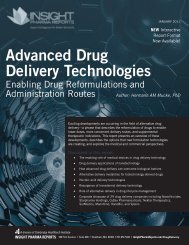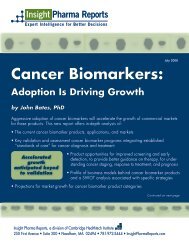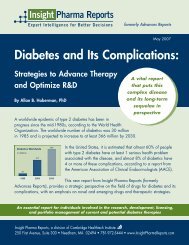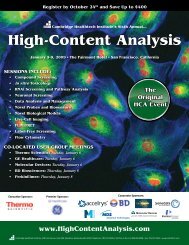2010 Best Practices Competition IT & Informatics HPC
IT Informatics - Cambridge Healthtech Institute
IT Informatics - Cambridge Healthtech Institute
- No tags were found...
Create successful ePaper yourself
Turn your PDF publications into a flip-book with our unique Google optimized e-Paper software.
Published Resources for the Life Sciences<br />
250 First Avenue, Suite 300, Needham, MA 02494 | phone: 781‐972‐5400 | fax: 781‐972‐5425<br />
D. ROI achieved or expected (200 words max.):<br />
Expected returns on this investment are many and include the tangible and intangible benefits and cost<br />
avoidance measures listed below:<br />
Tangible Benefits:<br />
• Cost savings through reduction of people‐hours for <strong>IT</strong> development, application deployment, system<br />
maintenance, and customer support for centralized implementation (versus distributed<br />
implementations to support labs separately)<br />
Intangible Benefits:<br />
• Improved security/reduced risk by managing a single, centralized pool of infrastructure resources<br />
(includes enterprise‐level security, storage, and back‐up; dedicated virtual LAN; failover/load‐sharing<br />
file services cluster and scheduler; and a single, formal disaster recovery and continuity of operations<br />
plan)<br />
• Increased awareness of bioinformatics resources available to labs at NIAID and other NIH Institutes<br />
• Elevated access to single, integrated team of subject matter experts including system administrators,<br />
infrastructure analysts, bioinformatics developers, and sequence analysis experts<br />
• Enhanced collaboration with research organizations external to NIAID that will take advantage of<br />
high‐performance computing environment<br />
• Improved research productivity to work toward combating/eradicating critical diseases<br />
Cost Avoidance:<br />
• Efficient use of centralized storage and computing resources used at higher capacity<br />
• Leveraged energy efficiency of data center power and cooling systems<br />
• Estimated 5‐fold savings in software licensing fees for shared deployment on cluster<br />
• Limited consolidation and migration costs for systems/data in centralized implementation<br />
E. CONCLUSIONS/implications for the field.<br />
Genomic research is a rapidly growing field with broad implications at the NIAID and in the global<br />
research community in general. Rather than having laboratory staff attempt to develop the requisite<br />
storage, network, and computing capacity themselves, NIAID’s Chief Information Officer has made a<br />
significant investment to centralize infrastructure resources in order to maximize efficiency and minimize<br />
cost and risk. Major network and storage upgrades, in addition to the construction of a powerful and<br />
scalable Linux computing cluster, are the most visible parts of this investment. However, additional<br />
personnel – including an experienced Linux Systems Administrator and bioinformatics support staff –<br />
have also been acquired. By utilizing the centralized infrastructure and resources, researchers doing<br />
important and influential work in immunology, vaccinology, and many other research areas that are<br />
immensely beneficial to the public will be better able to conduct their research.<br />
Large datasets and powerful multi‐core computers are not unique to Next Generation Sequencing. Other<br />
research areas of interest at the NIAID will also benefit from the new high‐performance computing<br />
resources. The NIAID has been able to reuse many of its successful development, procurement, and








